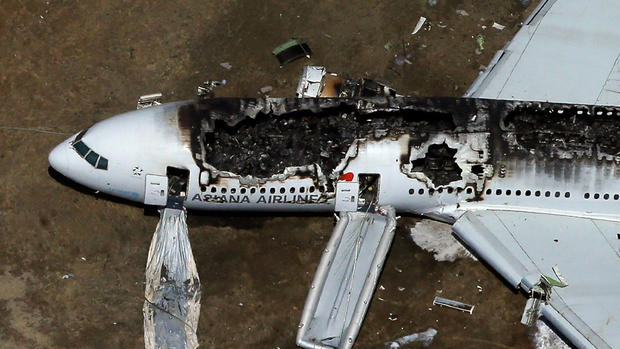Capt. Chesley Sullenberger: S.F. airport construction possible factor in crash
CBS News aviation and safety analyst Capt. Chesley Sullenberger told KCBS it was possible that ongoing construction at San Francisco International Airport will be examined as a factor in the Asiana Airlines crash that killed at least two people.
Sullenberger, the famed Bay Area pilot who landed the "Miracle on the Hudson" flight, said the construction might have been a contributing factor impacting landings at the facility. He said that the FAA-mandated construction is intended to increase the safety zone of the runway by moving it farther away from the seawall near where the plane crash landed.
A 2005 advisory issued by the FAA says "the goal is to construct an available runway length for new runways or extensions to existing runways that is suitable" for different kinds of airplane operations.
Officials told the Reuters news agency that a landing assistance system known as "Glide Path" had been turned off at San Francisco International for much of the summer, and while it was not unusual for the system to be turned off during good weather conditions, it would likely be another factor for investigators to consider.
"What that means is that then the automatic warnings that would occur in the cockpit when you deviate below the desired electronic path wouldn't have been available either. So we don't know yet if that's a factor in this particular situation, but that's certainly something they'll be looking at," Sullenberger told KCBS.
Sullenberger alsotold "CBS Evening News" Saturday anchor Jim Axelrod that San Francisco International has unique terrain.
"In fact, the FAA classified it as a special airport, along with other airports worldwide that involve mountainous terrain or other special challenges," he said. "It is surrounded by water, and of course water is a featureless terrain where depth perception can sometimes difficult be. There are shifting winds, low visibilities, so there are several things that make it special, plus high terrain just past it."
Sullenberger told KCBS that a nearby United Airlines crew may have had the best vantage point - "a front row seat" - to the crash to share with investigators. He said air traffic control tapes indicated the United flight was "holding short" to use that same runway next.
Arnold Barnett, an aviation expert at MIT, told KCBS it was possible the plane could have experienced a power shortage that caused pilots to lose control.
The National Transportation Safety Board said it was sending a team of investigators to San Francisco to probe the cause of the crash.
The 777-200 is a long-range plane from Boeing. The twin-engine aircraft is one of the world's most popular long-distance planes, often used for flights of 12 hours or more, from one continent to another. The airline's website says its 777s can carry between 246 to 300 passengers.
The flight was 10 hours and 23 minutes, according to FlightAware, a flight tracking service. The aircraft is configured to seat 295 passengers, it said.
The Boeing 777 is a smaller, wide-body jet that can travel long distances without refueling and is typically used for long flights over water.
The most notable accident involving a 777 occurred on Jan. 17, 2008 at Heathrow Airport in London. British Airways Flight 38 landed hard about 1,000 feet short of the runway and slid onto the start of the runway. The impact broke the 777-200's landing gear. There were 47 injuries, but no fatalities.
An investigation revealed ice pellets that had formed in the fuel were clogging the fuel-oil heat exchanger, blocking fuel from reaching the plane's engines. The Rolls-Royce Trent 800 series engines that were used on the plane were then redesigned.
Bill Waldock, an expert on aviation accident investigation, said he was reminded of the Heathrow accident as he watched video of Saturday's crash. "Of course, there is no indication directly that's what happened here," he said. "That's what the investigation is going to have to find out."
The last time a large U.S. airline lost a plane in a fatal crash was an American Airlines Airbus A300 taking off from John F. Kennedy International Airport in New York in 2001.
Smaller airlines have had crashes since then. The last fatal U.S. crash was a Continental Express flight operated by Colgan Air, which crashed into a house near Buffalo, N.Y. on Feb. 12, 2009. The crash killed all 49 people on board and one man in a house.
